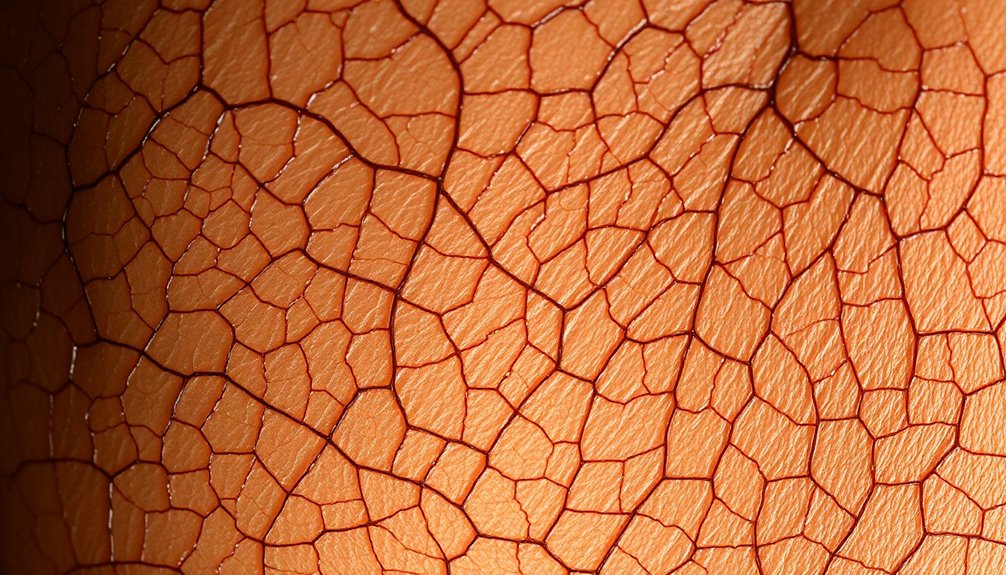Fractals aren't just a fascination of mathematics; they play an essential role in your body. You'll find fractal patterns in blood vessels, lungs, and even your brain's neurons. These repeating designs optimize blood flow, improve airflow, and enhance cognitive function. Fractals help maximize efficiency, ensuring your organs work seamlessly together. They also contribute to your health by reducing stress and improving mental clarity. Discovering these intricate connections can deepen your appreciation for life's complexity. There's so much more to explore about how these amazing patterns influence every part of your being and enhance your overall well-being.
Key Takeaways
- Human blood vessels branch in fractal patterns, optimizing blood flow and nutrient distribution throughout the body.
- The bronchial tree's fractal design enhances airflow and gas exchange, maximizing oxygen absorption in the lungs.
- Neurons exhibit fractal branching in dendrites, improving cognitive processing and communication between nerve cells.
- The heart's structure utilizes fractal geometry to efficiently pump blood, ensuring effective delivery to cardiac tissue.
- Kidneys and sweat glands demonstrate fractal characteristics, optimizing blood filtration and thermoregulation for overall health.
What Are Fractals?

Fractals are fascinating structures that embody never-ending patterns and self-similarity, where smaller parts mirror the whole at different scales. You mightn't realize it, but fractals are all around you, especially in the natural world. They can be found in various forms, from the branches of trees to the intricate designs of snowflakes.
When you observe these structures, you're witnessing fractal patterns that repeat in an infinitely complex manner.
In your body, fractals are essential for efficient functioning. For instance, the branching of bronchial tubes in your lungs forms a fractal pattern, optimizing gas exchange by ensuring that each small branch resembles the overall structure.
Similarly, your vascular system showcases fractals found in veins and arteries, which branch out in a self-similar way to enhance blood flow and nutrient distribution.
Even your nervous system isn't exempt; the structure of neurons features fractal patterns in the branching dendrites that boost connectivity and signal efficiency.
Recognizing these intricate designs in your anatomy reveals how deeply interconnected nature and your body truly are, highlighting the elegance of fractals in sustaining life.
Fractals in Human Anatomy
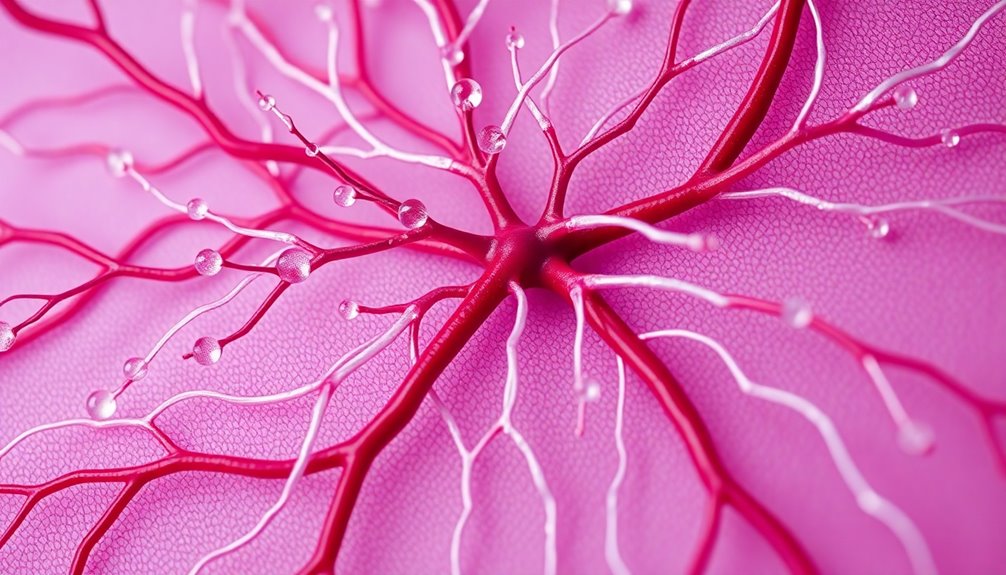
You may be surprised to learn just how deeply fractal patterns are woven into human anatomy. These intricate designs appear at every scale and in every part of your body, showcasing nature's efficiency in biological structures.
Here are some fascinating examples of fractals in human anatomy:
- Blood Vessels: The branching patterns of blood vessels resemble trees, ensuring efficient blood flow throughout your body.
- Bronchial Tree: In your lungs, the air passages branch out in a self-similar pattern, optimizing airflow and gas exchange.
- Neurons: The dendritic branching of neurons enhances connectivity and information processing within the brain, allowing for complex thought patterns.
- Heart Structure: The arrangement of cardiac cells in the heart reflects fractal geometry, contributing to its effective pumping mechanism.
These fractal patterns are essential for the functionality of your body, supporting the efficient operation of systems like circulation and respiration.
They illustrate how interconnected and optimized your anatomy is, a reflection of the complexity of life that binds every group of people together through shared biological blueprints.
The Role of Fractals in Health
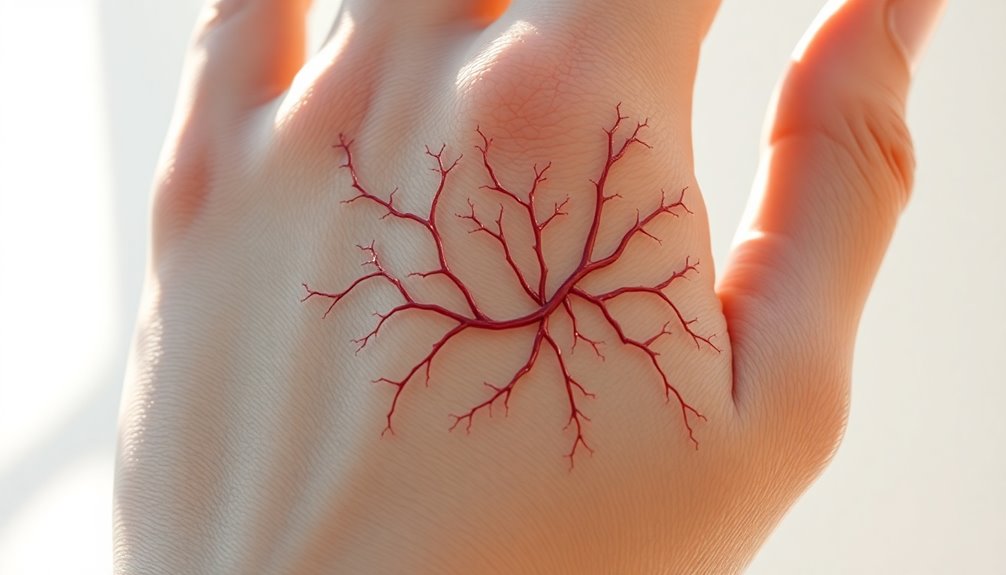
Fractals play an essential role in your health by optimizing how your body functions.
The branching patterns in your blood vessels and lung structures enhance nutrient delivery and gas exchange, while the fractal nature of brain connectivity supports cognitive resilience.
Understanding these patterns can help you appreciate how your body adapts and heals more effectively.
Fractals in Blood Vessels
While exploring the intricate systems of the human body, one quickly realizes that blood vessels exhibit remarkable fractal patterns that play an important role in maintaining health. Ever wonder how these patterns impact your well-being? Here are a few key points to take into account:
- Optimized Blood Flow: Fractal branching minimizes resistance and maximizes surface area for nutrient exchange, ensuring efficient circulation.
- Health Indicators: The fractal dimension of your blood vessel network is essential—deviations can signal cardiovascular diseases.
- Nutrient Distribution: The self-similar architecture distributes oxygen and nutrients effectively, supporting overall organ function.
- Stress Response: A healthy fractal network is linked to lower cortisol levels, aiding in better stress management.
Understanding these fractal patterns can open doors for medical breakthroughs. Researchers are investigating how this knowledge can improve treatments for conditions like atherosclerosis and hypertension.
Lung Structure Efficiency
The intricate design of the human lungs showcases a remarkable fractal branching pattern that enhances respiratory efficiency. This self-similar architecture optimizes surface area for gas exchange, allowing your lungs to hold about 300 million alveoli. Together, these structures provide a total surface area of around 70 square meters, maximizing oxygen absorption during each breath.
Here's a quick overview of how this fractal design benefits you:
| Feature | Benefit | Importance |
|---|---|---|
| Fractal Branching | Increases surface area for gas exchange | Enhances oxygen absorption |
| Self-Similarity | Distributes air efficiently | Minimizes resistance during airflow |
| Alveoli Count | Approximately 300 million | Supports high-volume air exchange |
Maintaining the integrity of this fractal organization is essential for your overall health. Disruptions can lead to respiratory issues, emphasizing the need for healthy lungs. By understanding the role of fractals in lung structure, you can appreciate the complexity and efficiency of your respiratory system, ultimately fostering better awareness of your lung health.
Brain Connectivity Patterns
Within the human brain, intricate fractal patterns emerge in how neurons connect, greatly enhancing communication across different regions.
These self-similar networks not only improve efficiency but also play an essential role in your cognitive performance. When you understand these patterns, you'll appreciate their significance for your mental health.
Here are four key insights about brain connectivity patterns:
- Cognitive Performance: Research shows that a higher fractal dimension correlates with better mental functioning, meaning more complex connections can enhance your cognitive abilities.
- Information Processing: Fractal structures facilitate rapid signal transmission, allowing for efficient integration of information across diverse neural pathways.
- Neurological Disorders: Disruptions in these fractal patterns are linked to various neurological disorders, underscoring their importance in maintaining mental health.
- Neuroplasticity: Engaging in activities like learning and creative pursuits promotes these fractal patterns, boosting your brain's adaptability and resilience. Additionally, emotional regulation is crucial in managing responses to stress, contributing to healthier brain connectivity.
Benefits of Fractal Patterns

Fractal patterns in nature offer a unique way to reduce stress and enhance your cognitive function.
When you engage with these designs, whether through art or natural landscapes, you may experience a sense of calm and improved mental clarity. Engaging with these patterns can also help you reset and recover from daily stressors, promoting overall well-being.
Let's explore how these patterns support healing and well-being.
Stress Reduction Techniques
Throughout history, humans have found solace in nature's intricate designs, and recent studies confirm that exposure to fractal patterns can significantly reduce stress levels. Engaging with these patterns, whether in nature or through visual representations, can lower your stress by up to 60%.
Imagine feeling the weight lifted off your shoulders after just 20 minutes of exposure.
To harness the benefits of fractal patterns in your life, consider these techniques:
- Natural Environments: Spend time in parks or natural landscapes where fractals abound, like trees and rivers.
- Fractal Art: Decorate your workspace or home with fractal artwork to create a calming atmosphere.
- Nature Photography: Use photographs of fractal-rich environments, such as forests or flowers, to bring a piece of nature indoors.
- Mindful Observation: Take a moment to observe fractal patterns in everyday objects, like leaves or shells, to ground yourself and reduce anxiety.
Incorporating these techniques into your routine can effectively lower cortisol levels, improve mental health, and promote overall well-being.
Embrace the fractals, and enjoy a more relaxed life!
Healing Through Nature
Experiencing nature's fractal patterns not only reduces stress but also offers profound healing benefits. Studies show that spending just 20 minutes in natural settings can lower your cortisol levels by up to 60%.
When you encounter these fractals, your brain processes them in about 50 milliseconds, triggering a relaxation response that promotes overall well-being.
Fractal designs, whether found outdoors or in artificial images, provide similar stress-relief benefits, positively impacting your mental health. Incorporating fractal patterns into your indoor spaces, like through artwork or natural elements, can enhance air quality and create a calming atmosphere that fosters healing.
Regularly interacting with fractals—whether through outdoor activities or biophilic design—correlates with lower blood pressure and heart rate, contributing to improved physical health. Additionally, exposure to natural environments reduces the harmful effects of wood-burning, which can further aid in promoting a healthier atmosphere for healing.
By immersing yourself in these natural patterns, you not only enjoy the beauty of your surroundings but also actively support your body's healing processes.
Enhancing Cognitive Function
The intricate designs of fractal patterns can considerably boost your cognitive function, acting like a mental workout for your brain.
These self-similar structures play a vital role in optimizing how your brain processes information and communicates between neurons.
Here's how fractals enhance your cognitive abilities:
- Improved Attention: Exposure to fractal images can sharpen your focus, helping you stay engaged in tasks longer.
- Enhanced Memory: Viewing fractal patterns has been linked to better retention of information, making it easier to recall facts.
- Reduced Mental Fatigue: Environments rich in fractal geometry, like natural landscapes, can decrease stress and refresh your mind.
- Optimized Neural Connectivity: The branching designs in your brain's architecture facilitate efficient connections, allowing for complex task handling.
Incorporating fractal patterns into your surroundings or therapeutic designs not only promotes brain health but also enhances your psychological well-being.
Fractal Geometry in Organs
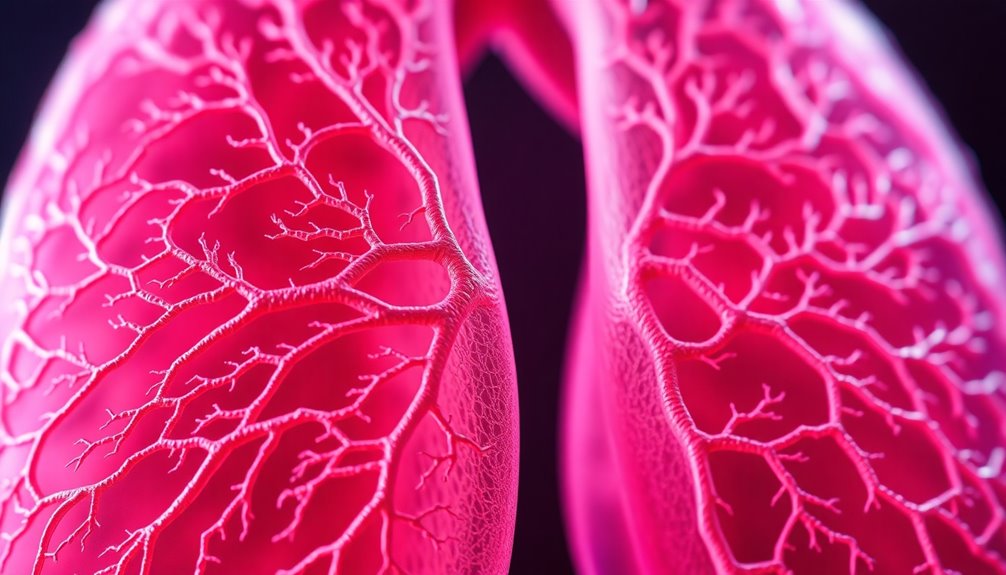
Fractal geometry plays an important role in the structure of various human organs, enhancing their efficiency and functionality. For instance, the human lungs showcase a fractal design where bronchi branch into smaller bronchioles. This intricate pattern maximizes surface area, greatly improving gas exchange, much like a tree's branches spread out to capture sunlight.
Similarly, blood vessels in your circulatory system exhibit fractal geometry. Arteries and veins branch out in a self-similar manner, ensuring efficient transport of nutrients and oxygen throughout your body.
The human brain also features a fractal structure, with neurons forming complex networks that enhance connectivity and processing, akin to the way trees branch out.
Your kidneys contain nephron units that demonstrate fractal characteristics, allowing for effective blood filtration. Their intricate tubular structures increase surface area, optimizing the filtering process.
Even your skin isn't left out; the arrangement of sweat glands follows fractal patterns, which play an important role in thermoregulation and moisture management.
These fractal designs aren't just fascinating; they illustrate how nature's mathematical principles optimize the vital functions of organs, ensuring your body operates at peak efficiency.
Nature's Influence on Biological Patterns

Nature's intricate designs have a profound impact on biological patterns within the human body. You might be surprised to discover how these fractal patterns enhance our bodily functions. Here are some fascinating examples:
- Vascular System: Your blood vessels branch out like a tree, maximizing efficiency in oxygen transport and nutrient delivery. This design guarantees your body gets what it needs to thrive.
- Lungs: The bronchioles in your lungs exhibit fractal geometry, creating a vast surface area for gas exchange. This intricate network allows for ideal respiration.
- Neurons: In your brain, neurons display fractal characteristics. Their dendritic trees branch out to form complex networks that enhance communication between cells, improving cognitive functions.
- Cerebral Cortex: The distribution of neurons in your cerebral cortex follows a fractal pattern, contributing to your brain's ability to process information efficiently and adapt to various stimuli.
These patterns not only reflect nature's beauty but also highlight the efficiency and functionality of human anatomy. Furthermore, the intricate designs found in nature, such as educational toys, can play a significant role in stimulating cognitive development in young children.
Fractals and Stress Reduction
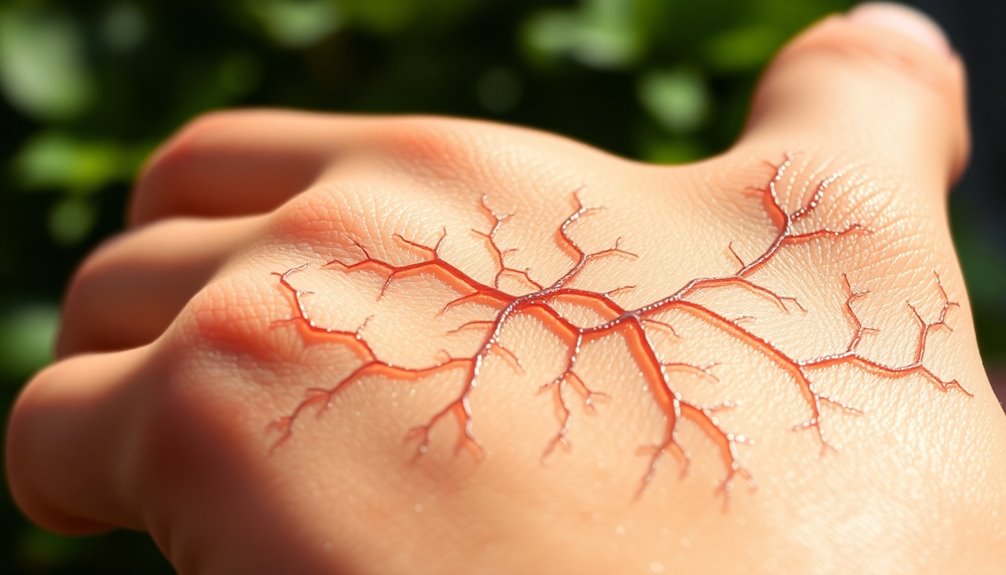
Amidst the chaos of daily life, discovering fractal patterns can be a key to reducing stress. Your brain can detect these patterns in about 50 milliseconds, triggering a sense of relaxation that diminishes stress levels. Just by looking at fractal images, especially those mimicking nature, you can experience considerable stress relief and improved mental health.
Engaging with nature, like observing the fractal designs in trees and landscapes, can reduce your stress levels by up to 60%. In just 20 minutes, cortisol levels can drop considerably, making you feel calmer and more centered.
Incorporating biophilic design principles into your living or working spaces can further enhance your well-being. When you surround yourself with fractal patterns and natural elements, you may notice lower blood pressure and heart rate, creating a more soothing environment.
Additionally, bringing real plants and fractal designs indoors not only alleviates stress but also improves air quality, giving you a double benefit. By embracing these fractal patterns, you can carve out moments of tranquility in your busy life and promote overall health.
Applications of Fractal Design
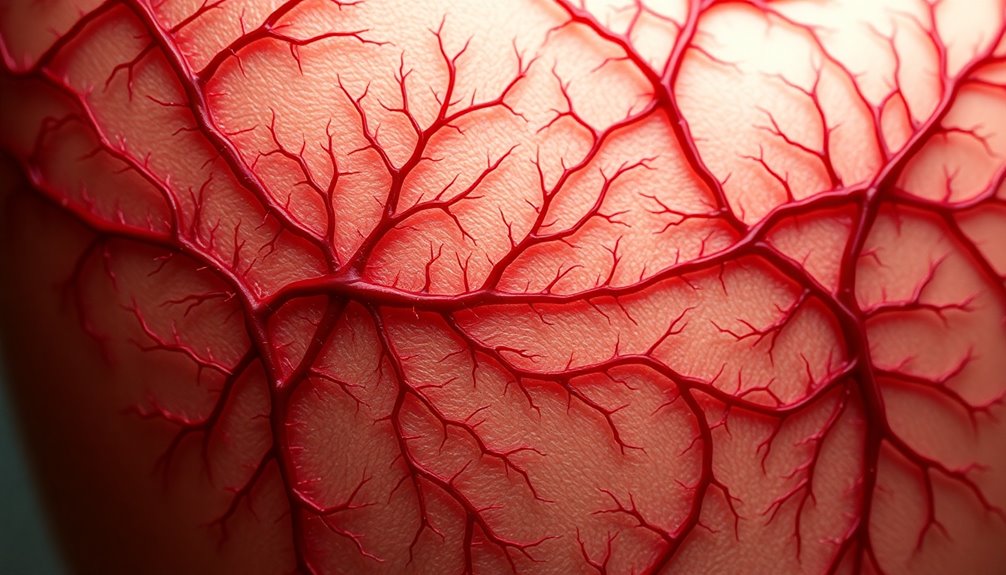
Discovering the calming effects of fractals can lead to practical applications that enhance various aspects of life. By embracing fractal design principles, you can reveal a multitude of benefits across different fields.
Here are four notable applications:
- Biological Systems: Fractal patterns optimize layouts, like blood vessels, improving oxygen transport efficiency within the body.
- Architecture and Urban Design: Incorporating fractal designs in buildings creates environments that promote well-being, reducing stress and enhancing mental health.
- Medical Devices: Fractal-inspired designs, such as fractal antennas, enhance signal reception and transmission, paving the way for advancements in telecommunications and diagnostic equipment.
- Neurological Research: Applying fractal geometry to understand neuron branching patterns provides better insights into brain connectivity and functionality, aiding in neurological studies.
Exploring Patterns in Life

Fractal patterns are everywhere in the human body, revealing a fascinating connection between biology and mathematics. You might be surprised to learn that the vascular system resembles the branching of trees, with blood vessels branching out in a similar self-similar manner. This design isn't just aesthetic; it optimizes blood flow and nutrient distribution throughout your body.
Your neurons also showcase these fractal patterns. The dendrites of neurons branch out in a way that enhances signal transmission in the brain, guaranteeing efficient communication between nerve cells.
Similarly, the structure of your lungs contains alveoli that maximize surface area for gas exchange while keeping a compact form, illustrating another crucial function of fractals in your body.
Even your heart isn't exempt. The branching of coronary arteries creates a network that guarantees effective blood delivery to cardiac tissue.
Each of these examples highlights how the intricate design of your body isn't random but instead follows the principles of fractal geometry. By exploring these patterns, you can gain a deeper appreciation for the complexity and efficiency of life itself, revealing the underlying mathematical beauty that supports your existence.
Frequently Asked Questions
What Are Some Examples of Fractals in the Human Body?
You'll find fractals in several parts of your body.
For instance, your blood vessels branch out like trees, optimizing blood flow.
In your lungs, the bronchi and smaller airways create a fractal structure that enhances gas exchange.
Your brain features dendritic trees in neurons, allowing complex signal processing.
Additionally, the convoluted intestines maximize nutrient absorption, showcasing these fascinating patterns throughout your biological systems, illustrating nature's efficiency in design and function.
Are Fractals Physically Possible?
Isn't it fascinating how nature loves to repeat itself? Fractals are indeed physically possible, showcasing patterns that repeat at different scales.
You can see these intricate designs in various forms, from coastlines to snowflakes. In your own body, fractals enhance efficiency and functionality, allowing for optimized structures like blood vessels and nerve connections.
What Is an Example of a Fractal Pattern in Real Life?
An example of a fractal pattern in real life can be seen in the branching of trees. When you look closely, you'll notice that the smaller branches mimic the shape of the larger trunk and branches. This self-similarity allows trees to efficiently capture sunlight while maximizing their stability.
Additionally, rivers exhibit fractal characteristics, as their winding paths resemble smaller streams and tributaries, creating a beautiful and intricate network throughout the landscape.
What Are Some Fractals in Real Life?
When you look closely at nature, you'll see beautiful repetitions in shapes and patterns.
Think of the way trees branch out or how coastlines curve—these are fractals. You can spot them in snowflakes, which exhibit intricate designs, and in the spiral of seashells, where each turn mirrors the last.
Even clouds create stunning fractal-like forms, revealing the enchanting order hidden within chaos.
These patterns remind you of nature's remarkable artistry and balance.
Conclusion
In the intricate dance of life, fractals mirror our existence, revealing the beauty hidden within our bodies. Just like a tree's branches reaching for the sky, these patterns embody resilience and harmony. Embracing the fractal nature of our anatomy invites healing and balance, reminding us that we're part of a greater whole. So, as you explore these mesmerizing designs, let them inspire you to connect deeper with yourself and the world around you.
